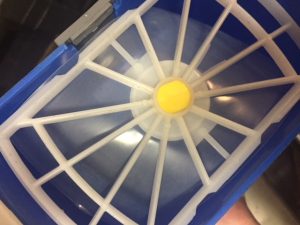Toilet won’t flush? There are several possible reasons why nothing happens when you pull the lever or push the button on your loo. In this article, we’ll explain the common faults and how you can fix them.
Toilet won’t flush – contents
Toilet cistern overview
In order to understand why your toilet won’t flush and how you can fix it, you need to know a bit about the parts in the cistern.
A typical British toilet uses a plastic siphon to draw water out of the cistern into the pan. Pulling the flush lever on a toilet raises a plastic diaphragm within the bell of the siphon. The diaphragm lifts a body of water up to the neck of the siphon, where it then spills over and down through the outlet. This starts a siphon and the rest of the water in the cistern empties into the pan. While the plastic diaphragm is flexible enough to allow the moving water to pass by it, a plastic frame underneath offers support. This ensures it has the rigidity to lift the water above the water line in the cistern.

A ball valve controls the refilling of the cistern. When the water level in the cistern falls, the valve opens, refilling the cistern for the next flush. If the ball valve fails, the overflow pipe allows the excess water to drain out of the cistern.
No water
If your toilet won’t flush, the very first thing to check is the contents of the cistern. Take the lid off and have a look inside – is there actually water in there? Take a look at the ball valve. Has the arm become jammed upwards? Gently moving the arm up and down may make the water flow again.
If the arm moves freely but the cistern does not refill, then the water supply to the cistern has become interrupted. There is usually an isolation valve on the supply pipe, which you can operate with a blade-edge screwdriver. Double check that this is open – the notch in the screw on the valve should be in line with the pipe. If it’s closed and there’s no reason not to open it, give it a quarter turn with a screwdriver.
Toilet cisterns get their water from the mains or from the cold water storage cistern in the loft. The cold cistern may also supply other cold outlets in the bathroom. It also supplies the hot water cylinder.
Check the other bathroom cold taps – do they work? If several other water outlets don’t work – and the kitchen cold tap does – then this suggests that the cold water storage cistern isn’t filling up. If you’re able to go up into the loft, take a look inside the storage cistern – there is a good chance it’ll be empty. Has the ball valve got stuck? Try the same thing with this ball valve and move the arm up and down. If the storage cistern starts to fill up, you have solved the problem. However, you should consider replacing the ball valve, as it may seize up again in future.
Toilet won’t flush – the flush mechanism
If the cistern is full of water, the next thing to consider is the flush mechanism. The flush lever on the outside of the cistern is connected to the diaphragm inside the siphon via a small chain or piece of plastic. This link attaches to the siphon via a metal loop or hook. A faulty flush mechanism may very well be the case if the flush lever feels extremely light and makes a different sound. Check to see if these components have become disconnected. If they have, reattaching them should solve the problem. If they’re broken, you should be able to buy replacement parts from your local DIY store or plumber’s merchant.
Broken diaphragm
If the flush mechanism works, the next thing to look at is the diaphragm. This may very well be the case if the toilet will only flush depending on how much force you use to push the lever. You may have noticed a certain “sweet spot” of pressure with which you need to pull the lever. Too much or too little, and the toilet won’t flush.
If the diaphragm is broken or has a hole in, it can’t raise the water above the spillover point inside the siphon. Instead, the water simply passes through the diaphragm. Simply replacing the diaphragm will solve the problem. If this isn’t possible, then you’ll need a new toilet siphon. Either of these solutions means isolating and draining the cistern, disconnecting the pipework and unscrewing it from the wall.